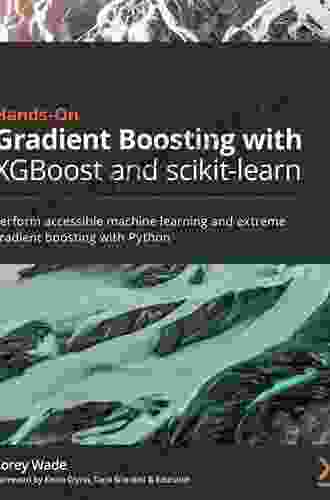Hands-On Gradient Boosting with XGBoost and Scikit-Learn

<meta name="keywords" content="Gradient Boosting, XGBoost, Scikit-Learn, Machine Learning, Decision Trees, Ensemble Methods"> Gradient boosting is a powerful ensemble machine learning algorithm that combines multiple weak learners, typically decision trees, to create a strong learner. It has gained immense popularity in recent years due to its high accuracy and efficiency in solving a wide range of classification and regression problems. In this hands-on article, we will dive into the world of gradient boosting using two of the most popular libraries for machine learning: XGBoost and Scikit-Learn. We will explore the theory behind gradient boosting, step-by-step implementation examples, and practical insights for optimal model performance. <h2>Understanding Gradient Boosting</h2> Gradient boosting is an iterative algorithm that builds an ensemble of decision trees sequentially. The key idea is to train each subsequent tree to correct the errors of previous trees. The algorithm starts by creating a simple decision tree on the training data. Then, it calculates the residuals (errors) of the tree's predictions. In the next iteration, a new decision tree is trained using the residuals as the target variable. This process continues until a specified number of trees is reached or until the model meets a certain performance criterion. The final prediction is the weighted average of the predictions from all the individual trees. <h2>XGBoost and Scikit-Learn</h2> XGBoost and Scikit-Learn are two of the most widely used libraries for machine learning in Python. XGBoost is a specialized library for gradient boosting, while Scikit-Learn provides a comprehensive set of tools for various machine learning tasks, including gradient boosting. XGBoost is renowned for its speed, scalability, and accuracy. It implements advanced techniques such as regularized learning, parallel computing, and tree pruning to achieve optimal performance. Scikit-Learn offers a more flexible and user-friendly interface, making it suitable for beginners and experienced practitioners alike. <h2>Implementation with XGBoost</h2> Let's start with a hands-on implementation of gradient boosting using XGBoost. We will use a real-world dataset to build a classification model for predicting customer churn. python import xgboost as xgb from sklearn.model_selection import train_test_split # Load the dataset data = pd.read_csv('churn.csv') # Split the data into training and testing sets X_train, X_test, y_train, y_test = train_test_split(data.drop('churn', axis=1),data['churn'], test_size=0.2, random_state=42) # Create the XGBoost model model = xgb.XGBClassifier(max_depth=5, n_estimators=100) # Train the model model.fit(X_train, y_train) # Evaluate the model on the test set score = model.score(X_test, y_test) print('Accuracy:', score) <h2>Implementation with Scikit-Learn</h2> Now, let's implement gradient boosting using Scikit-Learn. We will use the GradientBoostingClassifier class from the ensemble module. python from sklearn.ensemble import GradientBoostingClassifier # Create the GradientBoostingClassifier model model = GradientBoostingClassifier(n_estimators=100, max_depth=5) # Train the model model.fit(X_train, y_train) # Evaluate the model on the test set score = model.score(X_test, y_test) print('Accuracy:', score) <h2>Optimizing Model Performance</h2> To optimize the performance of your gradient boosting model, consider the following tips: * **Hyperparameter Tuning:** Tune the hyperparameters of the model, such as the number of trees, maximum depth, and learning rate, using cross-validation or optimization libraries. * **Feature Engineering:** Preprocess and transform your data to improve the model's understanding and predictive power. * **Data Balancing:** Handle class imbalance in the dataset to ensure the model is not biased towards the majority class. * **Early Stopping:** Monitor the model's performance on a validation set and stop training when the performance starts to degrade to prevent overfitting. * **Regularization:** Use regularization techniques, such as L1 or L2 regularization, to penalize complex models and enhance generalization performance. Gradient boosting is a powerful machine learning technique that offers high accuracy and versatility. In this article, we explored the basics of gradient boosting, provided practical implementation examples using XGBoost and Scikit-Learn, and discussed strategies for optimizing model performance. Whether you choose XGBoost or Scikit-Learn, embrace the power of gradient boosting to solve your machine learning challenges. Remember to experiment with different hyperparameters, preprocess your data wisely, and monitor your model's performance carefully to achieve the best possible results.4.6 out of 5
| Language | : | English |
| File size | : | 9466 KB |
| Text-to-Speech | : | Enabled |
| Screen Reader | : | Supported |
| Enhanced typesetting | : | Enabled |
| Print length | : | 310 pages |
Do you want to contribute by writing guest posts on this blog?
Please contact us and send us a resume of previous articles that you have written.
 Fiction
Fiction Non Fiction
Non Fiction Romance
Romance Mystery
Mystery Thriller
Thriller SciFi
SciFi Fantasy
Fantasy Horror
Horror Biography
Biography Selfhelp
Selfhelp Business
Business History
History Classics
Classics Poetry
Poetry Childrens
Childrens Young Adult
Young Adult Educational
Educational Cooking
Cooking Travel
Travel Lifestyle
Lifestyle Spirituality
Spirituality Health
Health Fitness
Fitness Technology
Technology Science
Science Arts
Arts Crafts
Crafts DIY
DIY Gardening
Gardening Petcare
Petcare Jenny Hall
Jenny Hall Justi Carey
Justi Carey Michael Wisehart
Michael Wisehart Irfan Ahmad
Irfan Ahmad Corey Wade
Corey Wade Steve Pease
Steve Pease Barbara Pachter
Barbara Pachter Stephanie Mcmurrich Roberts Phd
Stephanie Mcmurrich Roberts Phd James L Swanson
James L Swanson Geraldine Brooks
Geraldine Brooks Stephen E Dew
Stephen E Dew Gary Paulsen
Gary Paulsen Dawn Hogue
Dawn Hogue Dan Blanchard
Dan Blanchard Paul Lockhart
Paul Lockhart Joy Jones
Joy Jones Creek Stewart
Creek Stewart Joe Brooks
Joe Brooks Jerry R Thomas
Jerry R Thomas Eugene V Resnick
Eugene V Resnick Pat Brooks
Pat Brooks George Orwell
George Orwell Michael Wenz
Michael Wenz Zac Williams
Zac Williams Henry Bennett
Henry Bennett Donald Frias
Donald Frias Matthew M Hurley
Matthew M Hurley Michael Walker
Michael Walker Craig L Farnsworth
Craig L Farnsworth H W Brands
H W Brands Paul Ortiz
Paul Ortiz Jenny B Jones
Jenny B Jones Donald B Deyoung
Donald B Deyoung Sarah Guthals
Sarah Guthals John Miller
John Miller Dennis J Sweeney
Dennis J Sweeney Dianne Lake
Dianne Lake Brian Morris
Brian Morris Budd Bailey
Budd Bailey Joy Nash
Joy Nash Michael Morgan
Michael Morgan William Murakami Brundage
William Murakami Brundage Marie Lu
Marie Lu Jodi Lee
Jodi Lee Paula Hendricks
Paula Hendricks Sharon Begley
Sharon Begley Christopher Van Tilburg
Christopher Van Tilburg Susan B Bastable
Susan B Bastable Mark Broadie
Mark Broadie Supersummary
Supersummary Ta Nehisi Coates
Ta Nehisi Coates Winifred Conkling
Winifred Conkling Maia Szalavitz
Maia Szalavitz Joe Kelsey
Joe Kelsey Peter Newby
Peter Newby Rebecca Schiller
Rebecca Schiller Panos Y Papalambros
Panos Y Papalambros Shari Stauch
Shari Stauch Inc Barcharts
Inc Barcharts Bart Yasso
Bart Yasso Gary Morris
Gary Morris Ogi Ogas
Ogi Ogas Peter Ballin
Peter Ballin Tim Macwelch
Tim Macwelch Sally Huss
Sally Huss Marc Sedaka
Marc Sedaka Roberta M Gilbert
Roberta M Gilbert Archie Kalokerinos
Archie Kalokerinos Mike Malaska
Mike Malaska Eric Coll
Eric Coll Jordan Christy
Jordan Christy Sonia Weyers
Sonia Weyers Jen L Grey
Jen L Grey Mamma Margaret
Mamma Margaret Prince Daniels Jr
Prince Daniels Jr Richard Grant
Richard Grant Rael Isacowitz
Rael Isacowitz Stuart Tyson Smith
Stuart Tyson Smith Mike Liner
Mike Liner Kimberly Seals Allers
Kimberly Seals Allers Robert B Stone
Robert B Stone Theodore Kendris
Theodore Kendris Russell Elkins
Russell Elkins Erik Molvar
Erik Molvar Daniel Bezman
Daniel Bezman Chris Albon
Chris Albon Linda Hibbs
Linda Hibbs Richard Sale
Richard Sale Tracy Owens
Tracy Owens Ruth Albee
Ruth Albee Peggy A Houglum
Peggy A Houglum Nystce Exam Secrets Test Prep Team
Nystce Exam Secrets Test Prep Team Dan Jones
Dan Jones Victoria Duerstock
Victoria Duerstock Erfun Geula
Erfun Geula Mark Sundeen
Mark Sundeen Headquarters Department Army
Headquarters Department Army Gene Hamilton
Gene Hamilton Bill Keenan
Bill Keenan Tigran Bagdasaryan
Tigran Bagdasaryan Keiko Tobe
Keiko Tobe Anya Kuvarzina
Anya Kuvarzina Art Smith
Art Smith Kay Elder
Kay Elder Helen Leigh
Helen Leigh Carleen Eaton
Carleen Eaton Gaia Vince
Gaia Vince Thomas H Davenport
Thomas H Davenport Robbie Thompson
Robbie Thompson Leon Edward
Leon Edward Spanked Teen
Spanked Teen Jessica Wapner
Jessica Wapner Stephen Robson
Stephen Robson Melissa Wagner
Melissa Wagner Cari Rosen
Cari Rosen Carolyn Jessop
Carolyn Jessop Jerzy Jezierski
Jerzy Jezierski Carolyn Henry
Carolyn Henry Eli Lizorkin Eyzenberg
Eli Lizorkin Eyzenberg Ariella Moon
Ariella Moon Jacqueline Melvin
Jacqueline Melvin Nigel Foster
Nigel Foster Antonio Diego
Antonio Diego Richard Eng
Richard Eng Jennifer Comeaux
Jennifer Comeaux Ehren Myers
Ehren Myers Jim Ross
Jim Ross Michael Tyler
Michael Tyler Kristen Radtke
Kristen Radtke Kevin Salwen
Kevin Salwen Melissa Sperka
Melissa Sperka Harvey Penick
Harvey Penick Harry Vardon
Harry Vardon Doug Gelbert
Doug Gelbert Jonathan Benson
Jonathan Benson David J Anderson
David J Anderson Mario Batali
Mario Batali Sarah H Parcak
Sarah H Parcak Mr Michael Quilty Maguire
Mr Michael Quilty Maguire David Klausmeyer
David Klausmeyer Michael A Cremo
Michael A Cremo Joe Farinaccio
Joe Farinaccio Caroline Gallup
Caroline Gallup Joe Oswald
Joe Oswald Marie Tillman
Marie Tillman Gary Jobson
Gary Jobson Wyatt Mclaren
Wyatt Mclaren Frank Close
Frank Close Charles C Patrick
Charles C Patrick Thomas Celentano
Thomas Celentano Roger Kahn
Roger Kahn Laura Stamm
Laura Stamm Ron Kittle
Ron Kittle Shanaya Summer
Shanaya Summer Antony Felix
Antony Felix Second Edition Revised Kindle Edition
Second Edition Revised Kindle Edition Jon Finkel
Jon Finkel Patricia Ottaviano
Patricia Ottaviano Robert J Sternberg
Robert J Sternberg Lindsay Powers
Lindsay Powers Tashie Bhuiyan
Tashie Bhuiyan Colleen Doyle Bryant
Colleen Doyle Bryant Jonathan Robinson
Jonathan Robinson Justin Goldman
Justin Goldman Gigi Sayfan
Gigi Sayfan Mila Markle
Mila Markle Robert J Sweet
Robert J Sweet Ernest Thompson Seton
Ernest Thompson Seton Jean Anthelme Brillat Savarin
Jean Anthelme Brillat Savarin Diana Raab
Diana Raab Fiore Tartaglia
Fiore Tartaglia Kelly Jensen
Kelly Jensen Matt Appling
Matt Appling Shannon O Gorman
Shannon O Gorman Louie Giglio
Louie Giglio Brett Friedman
Brett Friedman Lynn Marriott
Lynn Marriott Emma Frisch
Emma Frisch Deirdre Dolan
Deirdre Dolan Cheng Liu
Cheng Liu Richard Griffith
Richard Griffith John Vonhof
John Vonhof Tim Collins
Tim Collins Lessie Myles
Lessie Myles Laura Taylor Namey
Laura Taylor Namey Philip C Plait
Philip C Plait Arous Brocken
Arous Brocken Mark Stavish
Mark Stavish Marge Foley
Marge Foley Corrine Morgan Thomas
Corrine Morgan Thomas Walter H Gmelch
Walter H Gmelch Jane R Hirschmann
Jane R Hirschmann Robert Solomon
Robert Solomon Roger Guay
Roger Guay Karen Ehman
Karen Ehman David Warriner
David Warriner Simon Pridmore
Simon Pridmore Samantha Michaels
Samantha Michaels Julie Hall
Julie Hall Karema Mcghee
Karema Mcghee Gregg Braden
Gregg Braden Tina Nicastro Maom Lac
Tina Nicastro Maom Lac Heather Renee
Heather Renee Grant Cunningham
Grant Cunningham George J Sanchez
George J Sanchez Todd Michael St Pierre
Todd Michael St Pierre Philip Mcmichael
Philip Mcmichael Cynthia Chen Mcternan
Cynthia Chen Mcternan Torre Deroche
Torre Deroche Ken Adcock
Ken Adcock Tamim Ansary
Tamim Ansary Tommy Nelson
Tommy Nelson Colin Stroud
Colin Stroud Martha Cheng
Martha Cheng Marcia Nathai Balkissoon
Marcia Nathai Balkissoon Richard Fortey
Richard Fortey Felicity Pulman
Felicity Pulman Austyn Lee
Austyn Lee Paul D Ellis
Paul D Ellis Melyssa St Michael
Melyssa St Michael William Hanson
William Hanson Giovanni Amato
Giovanni Amato Nancy Clark
Nancy Clark Julyen Rose
Julyen Rose Shane Parrish
Shane Parrish Justin A Reynolds
Justin A Reynolds Joseph F Healey
Joseph F Healey Paige Rawl
Paige Rawl Katie Rain Hill
Katie Rain Hill Harvey Berman
Harvey Berman Laurie Halse Anderson
Laurie Halse Anderson Jessica Dixie Mills
Jessica Dixie Mills Steven L Emanuel
Steven L Emanuel Pedro Casal
Pedro Casal Steve Raible
Steve Raible Db King
Db King Stephanie Dalley
Stephanie Dalley Ken Setterington
Ken Setterington Louise Douglas
Louise Douglas Anu Partanen
Anu Partanen Proper Education Group
Proper Education Group Markus Zusak
Markus Zusak Tom Burns
Tom Burns Lawrence J Cohen Phd
Lawrence J Cohen Phd Michelle Quach
Michelle Quach Joni L Mihura
Joni L Mihura Jeremy Paxman
Jeremy Paxman Herbert L Gravitz
Herbert L Gravitz Robin Horsfall
Robin Horsfall Ennki Hakari
Ennki Hakari Heather Turgeon
Heather Turgeon Douglas Riley
Douglas Riley Julie Tallard Johnson
Julie Tallard Johnson Dan Michaelson
Dan Michaelson Simon Singh
Simon Singh Greg Cruthers
Greg Cruthers Jessica Joelle Alexander
Jessica Joelle Alexander Sahara Foley
Sahara Foley Maya Angelou
Maya Angelou Jody Houser
Jody Houser Charles C Pinter
Charles C Pinter Ronald Mangravite
Ronald Mangravite Leigh Cowart
Leigh Cowart Kate Barrows
Kate Barrows Dm Fitzgerald
Dm Fitzgerald Alessandra Belloni
Alessandra Belloni April Lara
April Lara Dave Rineberg
Dave Rineberg Grayson Sinclair
Grayson Sinclair Naoko Abe
Naoko Abe Karen Newell
Karen Newell Sherry Thomas
Sherry Thomas Jessie James Decker
Jessie James Decker Anthony Idalion
Anthony Idalion Arrl Inc
Arrl Inc Sherry Blackman
Sherry Blackman John J Donohue
John J Donohue Henrik Gert Larsen
Henrik Gert Larsen J T Burns
J T Burns Chelsea Hanson
Chelsea Hanson Tom Wolfe
Tom Wolfe Anya Hayes
Anya Hayes Dr Lucie Rivera
Dr Lucie Rivera Abby Knox
Abby Knox Cara Natterson
Cara Natterson Erin Gruwell
Erin Gruwell Chandelle Lavaun
Chandelle Lavaun Eliana De Las Casas
Eliana De Las Casas Robert Wright
Robert Wright Antoine Savine
Antoine Savine Hamish Haswell Smith
Hamish Haswell Smith Kevin Brunette
Kevin Brunette R Scott Jones
R Scott Jones Phil Genova
Phil Genova Mark Harper
Mark Harper Revised Edition Kindle Edition
Revised Edition Kindle Edition John S Mbiti
John S Mbiti Marco Stiantoni
Marco Stiantoni James C Dobson
James C Dobson Bernard Darwin
Bernard Darwin Dr Mark Sircus
Dr Mark Sircus Tom Igoe
Tom Igoe Michelle Segar Phd
Michelle Segar Phd Gia Scott
Gia Scott Territory Supply
Territory Supply Jason Hanson
Jason Hanson Craig Caudill
Craig Caudill George Sandford
George Sandford Lou Paget
Lou Paget J Robert King
J Robert King Jennifer Karnopp
Jennifer Karnopp Mark Woods
Mark Woods Michael Pearle
Michael Pearle Odessa Gillespie Black
Odessa Gillespie Black Jason Reynolds
Jason Reynolds P J Capelotti
P J Capelotti Tasha Powers
Tasha Powers Daniel R Montello
Daniel R Montello Liz Wiseman
Liz Wiseman James Cordrey
James Cordrey Marty Smith
Marty Smith Richard A Horsley
Richard A Horsley Mark Fisher
Mark Fisher Michelle Oberman
Michelle Oberman James Ori
James Ori Rick L Huffman
Rick L Huffman Antony Cummins
Antony Cummins Emilio Iodice
Emilio Iodice John Booss
John Booss Meg Meeker
Meg Meeker Robert Clark
Robert Clark Yassine Tounsi
Yassine Tounsi David Robinson
David Robinson Shavona L Floyd
Shavona L Floyd Harald E L Prins
Harald E L Prins Miles Olson
Miles Olson Julitta Korol
Julitta Korol Jason Brick
Jason Brick Kindle Edition
Kindle Edition Bonnie Landry
Bonnie Landry Mira Ptacin
Mira Ptacin Antonia Felix
Antonia Felix Regan Parker
Regan Parker Don Kirk
Don Kirk Carl Sagan
Carl Sagan John Derbyshire
John Derbyshire Jeff Mayers
Jeff Mayers June Goulding
June Goulding Sophie Gonzales
Sophie Gonzales Rebecca Stobaugh
Rebecca Stobaugh Julie Murphy
Julie Murphy Clara E Hill
Clara E Hill Tharik Hussain
Tharik Hussain Jennifer M Bay Williams
Jennifer M Bay Williams Alan Bass
Alan Bass Elton Moraes
Elton Moraes Ian Condry
Ian Condry Chris Duff
Chris Duff Rick Riordan
Rick Riordan Joshua Enyart
Joshua Enyart Antonia Bolingbroke Kent
Antonia Bolingbroke Kent Jackson Carter
Jackson Carter Virginia M Axline
Virginia M Axline Steve Bo Keeley
Steve Bo Keeley Randy Gerke
Randy Gerke 2nd Edition Kindle Edition
2nd Edition Kindle Edition Conn Iggulden
Conn Iggulden Christina Thompson
Christina Thompson William Lanouette
William Lanouette Liz Lee Heinecke
Liz Lee Heinecke Herbert Warren Wind
Herbert Warren Wind Jayne Storey
Jayne Storey Deborah Miller
Deborah Miller Craig Storti
Craig Storti Jeff Galloway
Jeff Galloway Sara Wheeler
Sara Wheeler Philip S Harrington
Philip S Harrington Philip Pullman
Philip Pullman Jim Gourley
Jim Gourley Charlie Meyers
Charlie Meyers Stephanie R Haynes
Stephanie R Haynes Ji Kim
Ji Kim Daniela Sacerdoti
Daniela Sacerdoti Michael J Hathaway
Michael J Hathaway Hendrik Ebbers
Hendrik Ebbers Elisabeth Sheff
Elisabeth Sheff John N Maclean
John N Maclean Zigzag English
Zigzag English Karen Gravelle
Karen Gravelle Derek Dellinger
Derek Dellinger John Snygg
John Snygg Austin M Francis
Austin M Francis Peggy Mohan
Peggy Mohan David J Ley
David J Ley Thema Bryant Davis
Thema Bryant Davis Jennifer Scribner
Jennifer Scribner Philip Gerard
Philip Gerard Lenyfer Garrido
Lenyfer Garrido Benoit Mandelbrot
Benoit Mandelbrot Sasha Issenberg
Sasha Issenberg Estelle Frankel
Estelle Frankel You Fuguruma
You Fuguruma Tara Grayce
Tara Grayce Ian Freeman
Ian Freeman Steve Sheward
Steve Sheward Aquila Chrysaetos
Aquila Chrysaetos Gina Ford
Gina Ford Megan Whalen Turner
Megan Whalen Turner Kathleen Hale
Kathleen Hale Stephen Joseph
Stephen Joseph Mark Kurlansky
Mark Kurlansky Susy Callory
Susy Callory Go Books
Go Books Jef Aldrich
Jef Aldrich Iain Mcgilchrist
Iain Mcgilchrist Lauren Kahl
Lauren Kahl Peter Aitchison
Peter Aitchison Bradford Angier
Bradford Angier Stella Cottrell
Stella Cottrell Michael Symon
Michael Symon J Hannigan
J Hannigan Susie Johns
Susie Johns My Daily Russian
My Daily Russian Lara Kolawole
Lara Kolawole Laurence Gardner
Laurence Gardner George Kimball
George Kimball Silvana Condemi
Silvana Condemi Lj Andrews
Lj Andrews Krysten Harlow
Krysten Harlow 1st Ed 2020 Edition Kindle Edition
1st Ed 2020 Edition Kindle Edition Abbi Glines
Abbi Glines James Porzio
James Porzio The Pinnacle Review
The Pinnacle Review Reynaldo S Galang
Reynaldo S Galang Pharmacology University
Pharmacology University Aref Jeribi
Aref Jeribi J R Ward
J R Ward Jean Beaman
Jean Beaman Denny Emerson
Denny Emerson Carrie Shuchart
Carrie Shuchart Erving Goffman
Erving Goffman Amy R Carpenter
Amy R Carpenter Chuck Carlson
Chuck Carlson Joseph Distefano Iii
Joseph Distefano Iii Claudia Sanborn
Claudia Sanborn Jacki Pritchard
Jacki Pritchard Katharine A Phillips
Katharine A Phillips Martin Ganda
Martin Ganda Benny Lewis
Benny Lewis Michael Mccree
Michael Mccree Ton Viet Ta
Ton Viet Ta Andrew Miller
Andrew Miller Sara Lyon
Sara Lyon Brandon Royal
Brandon Royal Peter Nabokov
Peter Nabokov Sean Poage
Sean Poage Barbara Brown Taylor
Barbara Brown Taylor Jenny Moore
Jenny Moore James Atkinson
James Atkinson Karl F Kuhn
Karl F Kuhn Chris Carmichael
Chris Carmichael Susan Campbell Bartoletti
Susan Campbell Bartoletti Colleen Hoover
Colleen Hoover
Light bulbAdvertise smarter! Our strategic ad space ensures maximum exposure. Reserve your spot today!
 Eugene ScottFollow ·5.1k
Eugene ScottFollow ·5.1k José SaramagoFollow ·11.6k
José SaramagoFollow ·11.6k Henry HayesFollow ·4.3k
Henry HayesFollow ·4.3k Johnny TurnerFollow ·17k
Johnny TurnerFollow ·17k Howard BlairFollow ·11.4k
Howard BlairFollow ·11.4k Gabriel BlairFollow ·16.2k
Gabriel BlairFollow ·16.2k William ShakespeareFollow ·15.1k
William ShakespeareFollow ·15.1k Joseph FosterFollow ·13.9k
Joseph FosterFollow ·13.9k

 Bernard Powell
Bernard PowellAn Elusive World Wonder Traced
For centuries, the...

 Samuel Ward
Samuel WardAce Your Motorcycle Permit Test: 300 Essential Questions...
Obtaining a...

 Boris Pasternak
Boris PasternakTips for Leveling Up Refinement: Doing it With Class
Refinement is a...

 Willie Blair
Willie BlairThe Spare Room: A Haven for Art and Creativity in London
The Spare Room is a unique and inspiring...

 Howard Blair
Howard BlairThe Run-Walk-Run Method: Your Gateway to Running Success
Unlock Your Inner Runner ...
4.6 out of 5
| Language | : | English |
| File size | : | 9466 KB |
| Text-to-Speech | : | Enabled |
| Screen Reader | : | Supported |
| Enhanced typesetting | : | Enabled |
| Print length | : | 310 pages |














